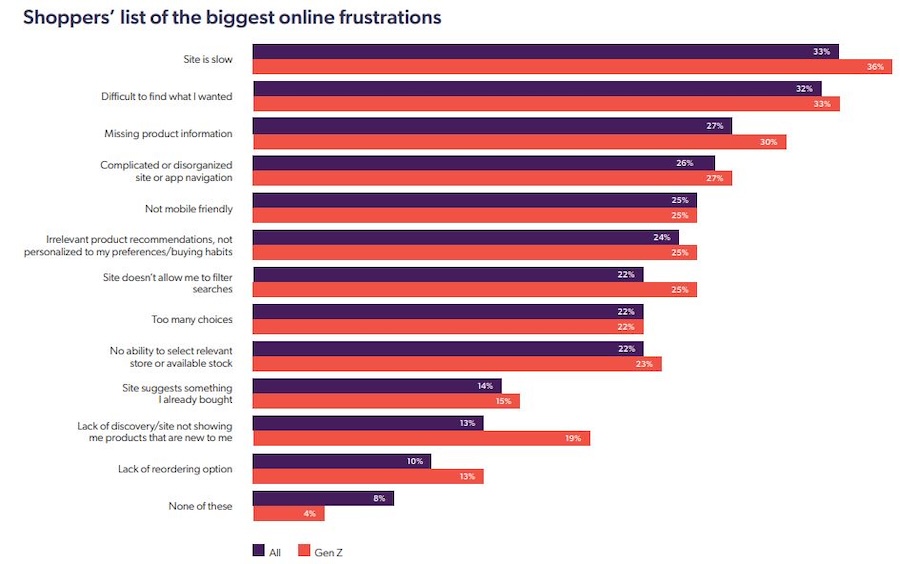
So, you’ve set up your online store, everything’s ready to go, and you couldn’t be any prouder.
Your website’s up and running, your products are all in stock, and you’re just itching to start filling up boxes and shipping out orders.
But despite your enthusiasm, you’ve barely made any sales, customers keep abandoning their carts, and at this point, you’d do just about anything to boost eCommerce sales.
To be fair, eCommerce problems are pretty common, both for retailers and shoppers, and today’s consumers have a lot of expectations when it comes to shopping online.
For example, in a survey from Coveo, which polled 4,000 shoppers from the U.S. and the U.K., 93 per cent of respondents said they “expect online shopping to be better than in-person shopping”.
What’s more, 91 per cent of respondents said they’ve encountered problems when shopping online, including things like poor site performance, missing product information, and irrelevant recommendations.

As you can see, in spite of their high expectations, consumers are dealing with a laundry list of many common eCommerce problems that are discouraging them from shopping online.
With that in mind, one of the best ways to differentiate yourself from other online retailers, and help to boost eCommerce sales, is to ensure your online store isn’t suffering from any of these issues.
Because when shoppers come to your store and have a seamless experience, and don’t have to deal with any of these frustrations, they’re going to be more inclined to do business with you again, and more likely to recommend your store to other people.
So, if you want to learn how to optimize your online store and boost eCommerce sales by providing the best possible experience for customers, then this article will definitely be worth your while.
Tips to Optimize Your Online Store and Boost eCommerce Sales

If you want to increase eCommerce sales, you’ve got to optimize your online store to make sure shoppers have a seamless experience.
With that in mind, these eCommerce optimization tips will help you address common eCommerce problems, improve your online store, and ultimately, sell more online:
1) Mobile Optimization
Everyone and their dog has a smartphone or tablet today, and that means optimizing your online store for mobile devices is absolutely essential.
By prioritizing mobile optimization, you’ll be catering to the growing number of consumers who prefer to shop on their mobile devices, thereby expanding your potential customer base and improving the experience consumers have shopping in your store.
Mobile optimization involves creating a seamless browsing and shopping experience for users, regardless of which device they’re using.
This includes doing things like implementing responsive design principles to ensure your website adapts gracefully to various screen sizes and resolutions.
2) Fast Loading Times
In today’s marketplace, consumers expect websites to load quicker than ever before, and as the years go by, their patience just seems to continue waning.
For example, a Digital.com survey, which polled 1,250 online shoppers, shows just how important site speed is when it comes to eCommerce sales.
53 per cent of respondents said they expect eCommerce pages to load in three seconds or less, and half of them said they will abandon their shopping carts if a page doesn’t load fast enough.
To optimize loading times, you can employ techniques such as image compression, minimizing HTTP requests, and leveraging browser caching, which will allow you to enhance user experience, keep shoppers on your site for longer, and increase the likelihood of conversions.
3) Clear Navigation
An intuitive navigation system is essential for guiding users through your online store and helping them find what they’re looking for efficiently.
This involves designing a user-friendly navigation menu that categorizes products logically and provides easy access to essential pages such as the home page, product catalog, and shopping cart.
It’s also important to incorporate a search bar with auto-complete functionality that enables users to quickly locate specific products.
These strategies help to enhance the experience shoppers have in your store and encourage them to explore your store’s offerings.
4) High-Quality Product Images
Visuals play a crucial role in eCommerce, not least because they allow customers to evaluate products and make informed purchasing decisions.
That being said, if you want to capture the attention of potential buyers and effectively convey the value of your products, you’ve got to include high-quality product images that showcase your offerings from multiple angles and perspectives.
By investing in professional photography and optimizing your product images for clarity and detail, you can enhance the visual appeal of your online store, inspire confidence in your offerings, and in turn, boost eCommerce sales.
5) Compelling Product Descriptions
In addition to captivating visuals, compelling product descriptions are incredibly important for persuading customers to make a purchase.
Well-crafted product descriptions should highlight key features, benefits, and unique selling points while addressing potential concerns or objections that customers may have.
You should also make sure that your product descriptions are as comprehensive and detailed as possible, so shoppers can have all the information they need to make their decision.
Crafting this kind of informative and persuasive copy for your product descriptions can help you increase eCommerce sales by allowing you to communicate the value of your products and differentiate them from your competitors’ offerings more effectively.
6) User Reviews and Testimonials
User reviews and testimonials from customers can significantly influence purchasing behaviour and can help to boost eCommerce sales, as they provide proof that other people have benefited from your products and/or services.
Prominently displaying this social proof on your online store provides prospective customers with reassurance and validation, which helps to build trust and credibility in your brand.
If you don’t have any testimonials, you can simply ask your existing customers to write them.
You’d be surprised how many customers will gladly do this for you, and you can even offer some incentives or rewards to encourage them if need be.
These testimonials will allow you to gather valuable feedback and collect user-generated content that can help boost eCommerce sales by enhancing your store’s reputation and fostering a sense of community.
7) Streamlined Checkout Process
The checkout process is a critical aspect of the customer journey, and optimizing it for simplicity and convenience can significantly impact your eCommerce sales.
As we already discussed, if your site is too slow, shoppers will simply abandon their carts, and because they’ve had that negative experience, they probably won’t come back.
That being said, if you want to increase eCommerce sales, you’ve got to do everything you can to ensure your store has a streamlined checkout process.
This includes doing things like eliminating unnecessary steps, offering guest checkout options, and providing multiple payment methods, which can help you improve customer satisfaction and maximize sales opportunities.
8) Personalized Recommendations
If you want to deliver relevant and engaging shopping experiences that resonate with individual customers, personalization is key.
By presenting customers with tailored recommendations that align with their interests and needs, you can increase cross-selling and upselling opportunities, enhance customer satisfaction, and drive repeat business.
Leveraging data and AI can allow you to generate these personalized product recommendations based on each customer’s browsing history, purchase behaviour, and preferences.
But if you want to avoid annoying your customers, make sure the recommendations you’re providing are as relevant as possible.
9) Optimized SEO
Search engine optimization (SEO) is essential for increasing visibility and driving organic traffic to your online store.
By optimizing product pages and content for relevant keywords, you can improve your site’s ranking on search engines like Google and attract qualified traffic from users who are actively searching for the products or services you offer.
You can also create valuable and informative content such as blog posts, guides, and tutorials, which not only enhances your site’s SEO but also establishes your brand as an authoritative resource within your niche and can help to further boost organic visibility and attract potential customers.
10) Social Proof and Trust Signals
Building trust and credibility is crucial if you want to convert visitors into customers.
With that in mind, displaying trust badges, security seals, and SSL certificates prominently on your website can help to instill confidence in visitors by establishing your store’s reliability and integrity, assuring them of secure transactions and data protection.
At the same time, showcasing social proof indicators such as social media followers, likes, and shares can serve as a testament to your store’s popularity and trustworthiness, further validating your brand and encouraging conversions.
11) Email Marketing Campaigns
Email marketing remains one of the most effective channels for nurturing customer relationships, driving engagement, and generating sales.
That being said, by building an email list of subscribers and customers, you can send targeted email campaigns that promote products, offer exclusive discounts, and announce special promotions or sales.
What’s more, using segmentation and personalization techniques can allow you to tailor your email content to specific audience segments based on demographics, purchase history, and preferences, which can increase the relevance of recommendations and improve conversion rates.
12) Abandoned Cart Recovery
Shopping cart abandonment is a common challenge for eCommerce retailers, but it also presents an opportunity for re-engagement and conversion.
Implementing abandoned cart recovery strategies, such as automated email sequences, enables you to follow up with customers who have abandoned their carts and remind them to complete their purchases.
What’s more, offering incentives such as discounts, free shipping, or limited-time offers can encourage customers to return to your site and finalize their transactions, helping you to reduce cart abandonment rates and recapture lost revenue.
13) Loyalty Programs
If you’re looking to boost eCommerce sales, fostering customer loyalty is essential, as it encourages customers to keep doing business with you.
Loyalty programs incentivize customers to engage with your brand regularly by offering rewards, discounts, or exclusive perks.
By rewarding customers for actions such as purchases, referrals, and social engagement, you can strengthen brand loyalty, encourage repeat business, and cultivate a loyal customer base that serves as passionate advocates for your brand.
14) Social Media Integration
Social media platforms provide valuable opportunities for engaging with customers, building brand awareness, and driving traffic to your online store.
Integrating social media into your eCommerce strategy allows you to leverage the power of social networks to promote products, showcase user-generated content, and interact with your audience in meaningful ways.
Making use of shoppable posts and ads, for example, enables you to facilitate direct purchasing from social media channels, which streamlines the path to purchase and allows you to take advantage of eCommerce trends on social media.
15) Continuous Testing and Optimization
Optimizing your online store is an ongoing process that requires extensive testing, analysis, and refinement.
By conducting A/B tests and experimenting with different elements of your website such as headlines, calls-to-action, and product layouts, you can identify what resonates best with your audience and what drives the highest conversions.
Monitoring analytics data, for instance, allows you to track performance metrics such as traffic, engagement, and conversion rates, enabling you to make data-driven decisions and revisit your strategy for continuous improvement.
16) Responsive Customer Support
Providing exceptional customer service is a fundamental part of building trust, resolving issues, and fostering positive relationships with customers.
For example, offering multiple channels for customer support such as live chat, email, and phone ensures that customers can reach out to you conveniently and receive timely assistance whenever they have questions or concerns.
Moreover, by responding promptly to inquiries, addressing customer issues effectively, and going above and beyond customers’ expectations, you can enhance the satisfaction and loyalty of your customers, which can help to improve eCommerce sales.
Do you need help setting up your online store? Give us a call today or check out our online payment solutions for more information.